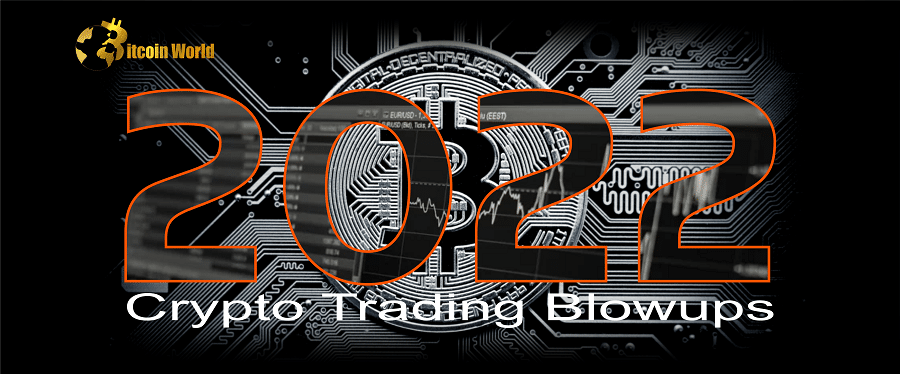2022. Just the mention of it sends shivers down the spines of crypto traders. It was a year where ‘expect the unexpected’ became the daily mantra, and not in a good way. Think you’ve seen a rough patch in the crypto market? 2022 set a new bar, and unfortunately, it wasn’t a high one. It was a year etched in the memories of even the most seasoned investors as a period of significant losses and shocking collapses. So, what exactly went down, and who were the key players in this drama?
A Year of Unprecedented Turmoil: How Did We Get Here?
Let’s be honest, 2022 felt like a never-ending series of unfortunate events. Just when you thought the market had hit rock bottom, another wave of bad news crashed in. We’re talking about a year where terms like ‘black swan event’ seemed almost commonplace. For many, it wasn’t just about losing profits; it was about witnessing the rapid disintegration of major players in the crypto space.
- Multiple Market Shocks: It felt like we experienced several ‘once-in-a-lifetime’ crises all within a single year. Remember the domino effect?
- The FTX Fallout: The collapse of FTX is still sending ripples through the industry, and the full impact is yet to be seen. Legal proceedings could drag on for quite some time.
- Wider Economic Pressures: It wasn’t just internal crypto issues. Global inflation, rising interest rates from the Federal Reserve, and geopolitical tensions added fuel to the fire, impacting both traditional finance (TradFi) and crypto markets.
The Notorious Trio: Who Suffered the Biggest Blows?
While many faced difficulties, three names stand out for their particularly dramatic falls. Let’s take a closer look at what happened:
Alameda Research and Sam Bankman-Fried: A House of Cards?
The story of Alameda Research and its founder, Sam Bankman-Fried (SBF), is perhaps the most talked-about saga of 2022. Once a prominent proprietary trading firm, Alameda found itself at the center of a massive scandal that led to its bankruptcy and the downfall of FTX.
What makes Alameda different? Unlike hedge funds that manage external capital, prop trading firms like Alameda primarily use the partners’ own money. This often means less transparency, and in Alameda’s case, it made understanding their true financial situation incredibly difficult.
However, the sheer scale of allegations from the SEC, CFTC, and federal prosecutors paints a grim picture. The accusations of commingling funds between FTX and Alameda suggest a level of mismanagement that shocked even seasoned crypto observers.
The departure of co-CEO Sam Trabucco before the major implosion hinted at trouble brewing beneath the surface. Caroline Ellison, the other co-CEO, has since pleaded guilty to federal charges, further highlighting the severity of the situation.
Multicoin Capital: Caught in the FTX Crossfire
Multicoin Capital, a well-respected crypto-focused hedge and venture fund, experienced a significant downturn in November, losing a staggering 51% in just two weeks. This was a sharp deviation from their typically strong performance.
So, what went wrong for Multicoin?
- FTX Exposure: A significant portion of their assets, including cash and derivatives, were held on the FTX exchange. While they managed to recover some funds, the damage was substantial.
- Market Volatility: The overall market chaos following the FTX collapse hit them hard.
- Solana Bet: Multicoin held a bullish position on Solana’s native token (SOL), which plummeted due to its close ties to SBF and projects like Serum.
Despite the losses, Multicoin’s predominantly institutional investor base speaks to the trust they had built over time. However, the events of 2022 served as a harsh reminder of the inherent risks in the crypto market.
Three Arrows Capital (3AC): Leverage and Liquidation
The story of Three Arrows Capital (3AC) often draws comparisons to Archegos Capital Management, Bill Hwang’s family office that imploded earlier. The common thread? Excessive leverage and a lack of transparency.
The Archegos Parallel: Just like Archegos used complex derivative swaps to mask their leverage from prime brokers, 3AC also concealed the true extent of their market exposure and borrowing.
Co-founders Su Zhu and Kyle Davies built a massive portfolio fueled by debt from various crypto lenders and prime brokers. This allowed them to engage in highly leveraged trades, which ultimately proved to be their undoing.
The end result for 3AC was a massive liquidation, leaving a trail of debt and highlighting the dangers of unchecked leverage in a volatile market.
Key Takeaways: Lessons Learned from the Crypto Winter of 2022
The events of 2022 offer some crucial lessons for anyone involved in the crypto space:
- Risk Management is Paramount: Understanding and managing risk is not optional; it’s essential for survival. Over-leveraging can lead to catastrophic consequences.
- Diversification Matters: Putting all your eggs in one basket, especially on a single exchange, can be incredibly risky.
- Transparency is Crucial: Lack of transparency can hide significant risks and make it difficult to assess the true financial health of a company.
- Due Diligence is Non-Negotiable: Thoroughly research the projects and platforms you invest in. Don’t rely solely on hype or endorsements.
- The Importance of Custody: Where your assets are held matters. The FTX collapse highlighted the risks associated with leaving significant funds on centralized exchanges.
Looking Ahead: What Can We Learn from the Past?
While 2022 was undoubtedly a difficult year, it also provided valuable lessons for the crypto industry. Moving forward, a greater emphasis on regulation, transparency, and risk management is crucial for building a more sustainable and resilient ecosystem. The failures of Alameda, FTX, Multicoin, and 3AC serve as stark reminders of the potential pitfalls and underscore the importance of caution and informed decision-making in the world of digital assets.
Disclaimer: The information provided is not trading advice, Bitcoinworld.co.in holds no liability for any investments made based on the information provided on this page. We strongly recommend independent research and/or consultation with a qualified professional before making any investment decisions.


